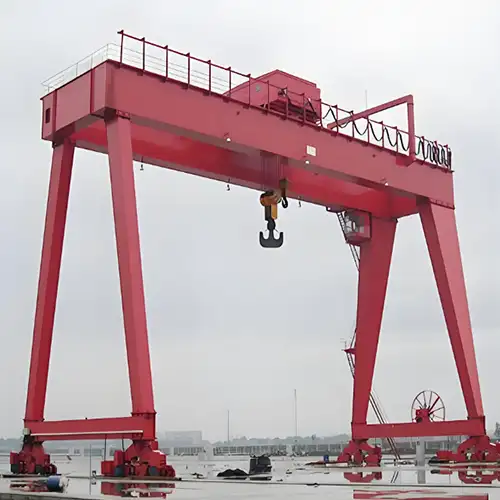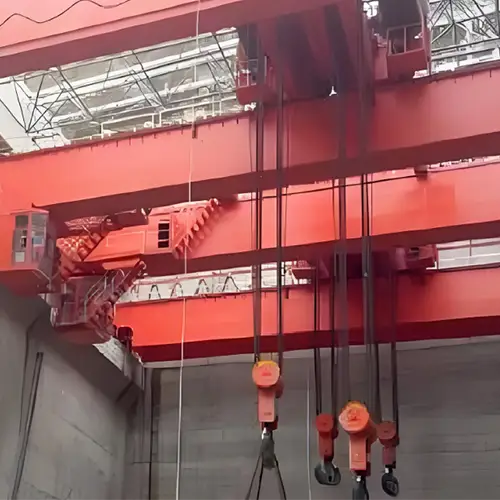Your Trusted Heavy Duty Crane Manufacturer & Supplier
32 Ton to 550 Ton Heavy Duty Cranes for Sale, Tailored Overhead Crane & Gantry Crane with Large Capacity for Heavy Lifting
Heavy Duty Cranes for Sale. 32 ton to 550 ton heavy-duty overhead cranes,i.e, bridge crane, gantry crane, jib crane designed for industrial heavy lifting.Explore our range of heavy-duty cranes, from 32 to 550 tons, designed for safe and efficient heavy lifting in any industry.
Heavy-duty cranes are essential tools in a wide range of industries, providing powerful lifting capabilities for heavy and bulky materials. These cranes are designed to handle substantial loads, making them crucial for operations in manufacturing, construction, logistics, and shipping. Their ability to lift, move, and position heavy items enhances efficiency and productivity, allowing businesses to streamline processes and minimize downtime.
There are three primary types of heavy-duty cranes: overhead cranes, gantry cranes, and jib cranes.
Heavy Duty Overhead Cranes
Heavy-duty overhead cranes are sophisticated lifting devices engineered to handle substantial loads efficiently and safely. Comprising a bridge that spans the workspace, these cranes operate on elevated tracks, allowing horizontal movement across large areas. The hoisting mechanism, suspended from the bridge, provides the capability to lift, lower, and transport materials vertically.
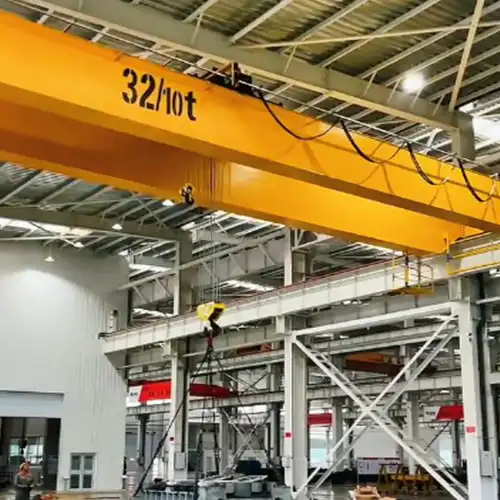
Double Girder Crane with Open Winch Trolley European style QDX
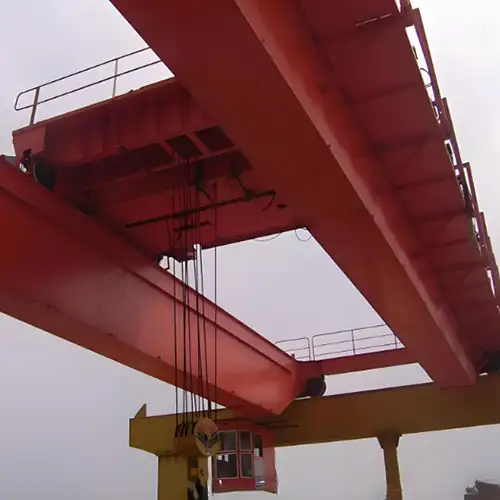
Double Girder Overhead Crane with Open Winch Trolley Traditional Style QD
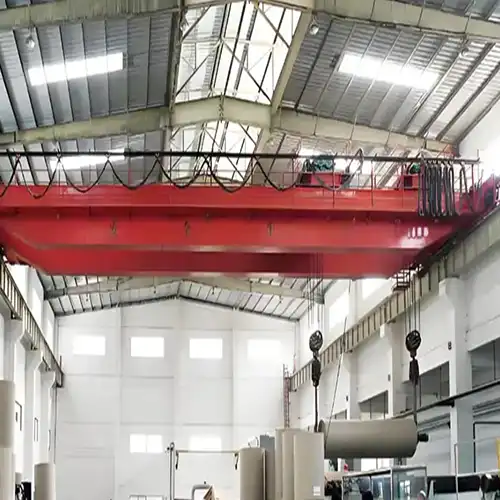
Double Grider Bridge Crane with Double Trolley
Key Features:
- Robust Design: Built to withstand heavy use and high stress, ensuring durability.
- Versatile Hoisting Systems: Equipped with various hoisting mechanisms, such as electric chain hoists or wire rope hoists, tailored to different lifting needs.
- Precision Control: Often fitted with advanced control systems that enhance the accuracy of load positioning.
Common Applications:
Heavy-duty overhead cranes find utility in numerous industries, each with specific operational requirements:
Manufacturing:
- Assembly Lines: Essential for moving large components throughout the production process.
- Material Handling: Efficiently lifts heavy machinery, metal sheets, and other materials, reducing manual labor.
- Maintenance Operations: Facilitates the removal and installation of heavy equipment for repairs.
Construction:
- Steel Erection: Used for lifting and positioning steel beams and trusses, crucial in building frameworks.
- Concrete Placement: Essential for transporting heavy concrete slabs and precast elements, streamlining construction timelines.
- Heavy Equipment Movement: Moves construction machinery and supplies around job sites with ease.
Logistics and Warehousing:
- Loading and Unloading: Speeds up the process of loading goods onto trucks and unloading containers in distribution centers.
- Storage Management: Capable of reaching high storage racks, maximizing vertical space and improving inventory management.
- Material Handling: Transfers goods between different areas within a warehouse, optimizing workflow efficiency.
In summary, heavy-duty overhead cranes are indispensable in sectors that demand reliable and efficient lifting solutions. Their versatility in handling various loads not only enhances productivity but also contributes to improved workplace safety by minimizing the risks associated with manual lifting.
Capacity Range
Heavy-duty overhead cranes are offered in various lifting capacities to accommodate the specific needs of different industries. Below is a detailed overview of the available capacities and their typical applications:
- 32 Ton: Ideal for medium to heavy lifting tasks, commonly used in manufacturing and assembly lines, particularly in automotive plants for handling engine components.
- 50 Ton: Suitable for heavy industrial applications, frequently employed in warehouses to move bulk materials and large machinery, as well as in steel fabrication.
- 75 Ton: Often utilized in construction sites for lifting heavy beams and precast concrete elements, and effective in heavy-duty manufacturing environments like aerospace and shipbuilding.
- 80 Ton: Excellent for specialized applications that require precise lifting of large structures, commonly used in both manufacturing and construction for handling heavy industrial equipment.
- 100 Ton: Frequently found in steel mills and heavy manufacturing facilities, ideal for moving large components in power plants and significant construction projects.
- 160 Ton: Designed for extremely heavy loads, suitable for specialized industrial applications such as shipyards and heavy construction like bridge building.
- 200 Ton: Ideal for transporting massive structural components and machinery, commonly utilized in large manufacturing facilities where significant lifting capacity is essential.
- 250 Ton: Built for extraordinary lifting requirements, often seen in large construction projects and heavy industries, including oil and gas sectors.
- 320 Ton: The highest capacity available, designed for the most demanding lifting applications, typically used in heavy engineering, shipbuilding, and large-scale construction projects.
Selecting the appropriate crane capacity is crucial for ensuring optimal performance and safety in lifting operations. Consideration of load weight, dimensions, and operational conditions will guide the choice of the best crane for specific tasks.
Features and Specifications
Heavy-duty overhead cranes come equipped with various features and specifications that enhance their performance and usability.
Key Features:
- Lifting Mechanisms:Commonly utilize electric chain hoists or wire rope hoists for lifting operations. These mechanisms provide reliable and efficient lifting capabilities tailored to specific load requirements.
- Control Systems:Advanced control systems enable precise maneuvering of loads. Options include radio remote controls and cab controls, allowing operators to manage lifting operations from a safe distance.
Safety Features:
- Overload Protection:Integrated overload protection systems prevent the crane from lifting loads exceeding its rated capacity, reducing the risk of accidents.
- Emergency Stops:Emergency stop buttons are strategically placed for quick access, ensuring immediate halting of crane operations in case of emergencies.
- Limit Switches:Limit switches help control the upper and lower limits of the crane's movement, preventing over-travel and potential collisions.
Customization Options:
- Tailored Configurations:Cranes can be customized to meet specific application requirements, including different span lengths, lifting heights, and configurations (e.g., single girder vs. double girder).
- Specialized Attachments:Various attachments can be added, such as hooks, clamps, or slings, to enhance functionality for specific lifting tasks.
Benefits of Heavy Duty Overhead Cranes
Heavy-duty overhead cranes offer numerous advantages that significantly contribute to operational efficiency and workplace safety.
- Efficiency and Productivity Improvements:These cranes enable quick and efficient movement of heavy loads, reducing manual handling and associated labor costs.Enhanced lifting capabilities allow for faster completion of tasks, improving overall productivity in manufacturing, construction, and logistics environments.
- Space-Saving Design Advantages:The overhead design of these cranes maximizes floor space, allowing for more effective use of the working area beneath.Their ability to lift and move loads vertically reduces the need for extensive ground-level space, making them ideal for facilities with limited operational space.
In summary, the advanced features and numerous benefits of heavy-duty overhead cranes make them indispensable tools in various industries, enhancing both safety and efficiency in heavy lifting operations.
Heavy Duty Gantry Cranes
Heavy-duty gantry cranes are robust lifting systems designed to move heavy loads across a wide range of applications. These cranes feature a bridge supported by vertical legs that straddle the load area, allowing for both vertical and horizontal movement. This design provides significant versatility, enabling the crane to operate in various environments.
- Structure: A typical heavy-duty gantry crane consists of a horizontal beam (the bridge) supported by two or more legs. The legs can be equipped with wheels or tracks, allowing the crane to move along a designated path or remain stationary.
- Lifting Mechanism: These cranes usually incorporate electric hoists or other lifting systems, enabling them to handle substantial weights safely and efficiently.

Double Girder Gantry Crane with European Style Open Winch Trolley

Heavy Duty Gantry Crane with Double Trolleys 75 ton + 75 ton for your reference

Heavy Duty Gantry Crane with U frame Gantry Design
Common Uses:Heavy-duty gantry cranes are utilized in a variety of settings, making them indispensable for several industries:
Outdoor Applications:
- Construction Sites: Frequently used to lift and position large materials, such as steel beams and precast concrete, during building projects.
- Shipyards: Ideal for moving heavy ship components, equipment, and materials, enhancing operational efficiency in maritime industries.
Indoor Applications:
- Manufacturing Facilities: Commonly used for handling heavy machinery, components, and materials in assembly lines and production processes.
- Warehousing: Effective for loading and unloading trucks, as well as moving heavy goods within storage areas, optimizing space and workflow.
The versatility of heavy-duty gantry cranes allows them to adapt to various lifting tasks, whether indoors or outdoors, making them a vital asset in many industrial applications. Their ability to handle substantial loads with precision contributes to improved productivity and safety in the workplace.
Capacity Range
Heavy-duty gantry cranes are available in a wide array of lifting capacities to meet the diverse needs of various industries. Here's an overview of the available capacities and their typical applications:
- 32 Ton: Suitable for medium to heavy lifting tasks, commonly used in manufacturing and assembly applications.
- 40 Ton: Ideal for lifting heavy materials in construction and steel fabrication, often employed in warehouses.
- 50 Ton: Frequently used in heavy-duty manufacturing environments, particularly for transporting heavy machinery and components.
- 75 Ton: Often found on construction sites, enhancing productivity by lifting substantial loads like steel beams and concrete panels.
- 80 Ton: Excellent for specialized applications requiring precise lifting of large items in construction and industrial sectors.
- 100 Ton: Commonly utilized in heavy manufacturing facilities for moving large components in power generation and other heavy industries.
- 160 Ton: Designed for extremely heavy lifting tasks, suitable for specialized industrial applications like shipbuilding.
- 200 Ton: Ideal for transporting massive structural components, frequently used in large-scale manufacturing and heavy engineering.
- 250 Ton: Built for extraordinary lifting requirements, commonly found in oil and gas sectors and large construction projects.
- 320 Ton: One of the highest capacities available, designed for demanding lifting applications in heavy engineering.
- 500 Ton: The highest capacity offered, suitable for extremely heavy loads in specialized applications such as shipyards.
Selecting the appropriate lifting capacity for a gantry crane is essential for ensuring safe and efficient operations. Each capacity range caters to specific lifting needs, allowing businesses to optimize their material handling processes effectively.
Features and Specifications
Heavy-duty gantry cranes come with a variety of features and specifications that enhance their functionality and adaptability.
Structural Designs:
- Single Girder: Lightweight and cost-effective, suitable for lighter loads and limited lifting heights, ideal for small-scale operations and indoor environments.
- Double Girder: Provides increased strength and stability for handling heavier loads, suitable for high-lift applications, often used in larger industrial settings.
Mobility Features:
- Wheel Types: Various wheel designs, including solid rubber and steel, allow for smooth movement on different surfaces, enhancing mobility and stability.
- Towing Options: Some gantry cranes can be equipped with towing capabilities, allowing them to be moved easily between different job sites or applications.
Customization Options:
- Tailored Configurations: Cranes can be customized for specific lifting heights, spans, and configurations based on operational needs.
- Special Attachments: Options for various attachments, such as spreader beams, hooks, or specialized lifting devices, enable the crane to handle unique loads efficiently.
Benefits of Heavy Duty Gantry Cranes
Heavy-duty gantry cranes offer numerous advantages that make them a preferred choice in various industrial applications.
- Cost-Effectiveness Compared to Fixed Cranes:Gantry cranes typically have lower initial installation and maintenance costs compared to fixed cranes, making them a budget-friendly option for many businesses, while their mobility allows for use in multiple locations, eliminating the need for multiple fixed installations.
- Versatility in Handling Various Loads:Capable of lifting a wide range of loads, from light to extremely heavy, these cranes can adapt to different applications in construction, manufacturing, and warehousing, and the ability to customize configurations and attachments further enhances their versatility.
Overall, heavy-duty gantry cranes combine structural integrity with mobility and adaptability, making them an essential tool for efficient material handling across various industries.
Heavy Duty Jib Cranes
Heavy-duty jib cranes are versatile lifting solutions designed to provide effective material handling in a range of industrial settings. These cranes feature a horizontal arm (the jib) that extends out from a vertical support structure, allowing for efficient lifting and moving of heavy loads.
Typical Applications:
- Workshops: Frequently used in manufacturing and repair shops for lifting machinery parts and tools, enhancing workflow and productivity.
- Production Areas: Commonly found in assembly lines and production facilities, where they facilitate the quick movement of materials and components, improving operational efficiency.

Pillar Column Mounted Jib Crane

Anticorrosion Jib Crane

10 Ton Jib Cranes
Capacity Range
Heavy-duty jib cranes come in several lifting capacities to accommodate different applications:
- 10 Ton: Suitable for moderate lifting tasks in workshops and manufacturing environments, ideal for handling machine parts and equipment.
- 16 Ton: Provides additional lifting capacity for heavier loads, often used in industrial applications requiring robust handling capabilities.
- Customized Options up to 20 Ton: Allows for tailored solutions based on specific operational needs, ensuring optimal performance for unique lifting tasks.
Features and Specifications
Heavy-duty jib cranes are designed with various features to enhance their functionality and safety.
Design Variations:
- Pillar-Mounted: Fixed to a vertical column, offering stable support for lifting operations, commonly used in workshops and production areas.
- Wall-Mounted: Attached to a wall or structure, maximizing space efficiency and providing reach in confined areas.
Rotation and Reach Capabilities:
- These cranes typically offer a range of rotation angles, allowing operators to maneuver loads easily around obstacles and access hard-to-reach areas, enhancing versatility.
Safety Features:
- Limit Switches: Prevent over-travel of the lifting mechanism, ensuring safe operation within designated limits.
- Emergency Stops: Easily accessible emergency stop buttons allow for quick cessation of crane operations in case of emergencies, enhancing worker safety.
Benefits of Heavy Duty Jib Cranes
Heavy-duty jib cranes provide several advantages that make them invaluable in various industrial applications.
- Space Efficiency and Flexibility:Their design allows for optimal use of floor space, making them ideal for operations in confined areas where traditional cranes may not fit. This flexibility supports efficient workflow and minimizes disruption in busy environments.
- Ease of Use in Confined Areas:Jib cranes can be positioned close to workstations, providing direct lifting access without the need for extensive maneuvering, which is particularly beneficial in tight spaces.
Investing in heavy-duty cranes offers significant advantages, including improved efficiency, safety, and adaptability across various applications. When selecting a crane type, it's essential to consider specific needs and operational requirements to ensure optimal performance and productivity. By understanding the benefits of heavy-duty cranes, businesses can make informed decisions that enhance their material handling processes.
Typical Crane Design Structures for Heavy Duty Cranes

Box Girder Design
- Structure: This design features a hollow rectangular shape, providing high strength and stability while being lighter than traditional I-beams. It minimizes deflection and enhances load capacity.
- Applications: Ideal for heavy-duty operations, such as those in steel mills or heavy manufacturing, where minimizing weight without sacrificing strength is essential.
Double Girder Design
- Structure: Comprising two parallel girders, this design allows for greater lifting height and load capacity. It supports heavier loads and larger spans compared to single girder cranes.
- Applications: Commonly found in heavy industrial settings, such as automotive assembly plants and large warehouses, where robust lifting solutions are needed.
Open Winch Trolley
- Lifting System: This system utilizes an open winch mechanism, facilitating easy maintenance and reducing weight. It accommodates various lifting speeds, making it versatile for different applications.
- Benefits: Offers high efficiency in lifting operations and can be customized to meet specific load requirements.

Safety Features
- Double Brakes: Essential for critical applications like lifting steel ladles in foundries, double brakes provide an extra layer of safety to prevent accidental drops.
- Overload Protection: Integrated systems prevent lifting beyond the rated capacity, ensuring operational safety and protecting equipment from damage.
Anti-Collision Devices
- Functionality: These sensors and systems are designed to prevent cranes from colliding with other equipment or structures in busy environments. They enhance safety, particularly in multi-crane operations or spaces with limited room.
Smart Optional Features
- Control Systems: Advanced technologies, such as PLC (Programmable Logic Controllers), enable precise operation and monitoring of crane functions. Remote control capabilities further enhance operator convenience and safety.
- Data Analytics: Sensors collect data on usage patterns, wear, and performance, facilitating predictive maintenance and improving operational efficiency.
These design components contribute to the enhanced safety, efficiency, and reliability of heavy-duty cranes, making them suitable for demanding lifting tasks across various industrial applications.
Typical Below Hook Devices Used
- Hooks: Basic lifting device, available in various sizes and styles, often used for general lifting tasks.
- Slings: Fabric or metal straps used to secure loads for lifting, including web slings, chain slings, and wire rope slings.
- Lifting Beams: Horizontal beams that distribute weight and allow for lifting multiple points on a load, enhancing stability.
- Spreader Bars: Used to spread the load's weight evenly, particularly for wide or bulky items, preventing damage during lifting.
- Magnetic Lifters: Devices that use magnets to lift ferrous materials, providing a secure hold without the need for slings.
- Grab Devices: Mechanisms designed to pick up and hold various materials, especially bulk items like scrap metal or aggregates, providing secure and efficient handling.
Typical Applications of Heavy Duty Cranes
- Manufacturing Facilities: Heavy-duty cranes are essential for moving large components and equipment in manufacturing plants, such as automotive and aerospace. These environments often have high ceilings and expansive floor spaces, allowing for the efficient use of cranes to transport heavy loads between production lines. They enable efficient transport of heavy loads, enhancing workflow and productivity while ensuring safety.
- Steel Mills: In steel mills, heavy-duty cranes are crucial for handling molten metal and heavy steel products. The continuous operations of these facilities demand cranes that can lift substantial weights and withstand extreme conditions. Their robust design is vital for maintaining safety and efficiency in steel production processes.
- Construction Sites: Heavy-duty cranes play a key role in lifting and moving large construction materials, such as steel beams and concrete panels. These cranes are essential in busy construction environments where safety and timely completion are critical. They provide the necessary lifting capacity to meet the demands of large-scale projects, ensuring safe and efficient operations.
- Shipyards: In shipbuilding and repair, heavy-duty cranes are used to handle massive components like hull sections and engines. The demanding nature of shipyard operations requires cranes that can manage heavy and cumbersome loads effectively. Their high lifting capacity and durable construction are essential for the safe handling of large maritime components.
- Oil and Gas Industry: Heavy-duty cranes are utilized to lift large equipment and materials in hazardous environments, such as offshore platforms and refineries. These cranes must operate reliably under extreme weather conditions and corrosive environments. Their specialized design ensures safe and effective handling of heavy loads in critical operations.
- Ports and Terminals: Cranes at ports and terminals facilitate the efficient loading and unloading of shipping containers and bulk materials. The high frequency of crane use in these busy environments requires robust designs for optimal performance. Heavy-duty cranes are essential for quick turnaround times, enhancing logistical efficiency and safety.
- Power Plants: In power plants, heavy-duty cranes are vital for the installation and maintenance of large equipment, such as turbines and generators. These operations often involve handling heavy and sometimes hazardous materials. High safety standards and specialized lifting devices are necessary to protect workers and ensure safe handling.

Gantry Crane with Double Trolley for Heavy Conceret Block Handling in Construction

Explosion Proof Cranes for Oil and Gas Industrial Material Handling
Why Heavy Duty Cranes Are Required
Heavy-duty cranes are essential across various industries for several reasons:
- High Load Capacity: They are designed to handle very large and heavy loads that standard cranes cannot lift, making them indispensable in operations that involve substantial materials.
- Safety: With features such as overload protection, double brakes, and anti-collision devices, heavy-duty cranes ensure safe operations in environments where heavy lifting is routine.
- Efficiency: Their ability to lift and move heavy loads quickly and safely enhances productivity in manufacturing, construction, and logistics.
- Durability: Designed to withstand harsh environments and continuous use, heavy-duty cranes offer long-term reliability and reduce maintenance needs.
- Versatility: Heavy-duty cranes can be customized with various below-hook devices, such as grabs and hooks, to suit specific handling requirements, making them adaptable for diverse applications.
In summary, heavy-duty cranes are critical for the safe and efficient handling of heavy, large, or hazardous loads in busy industrial environments, significantly contributing to operational success.

